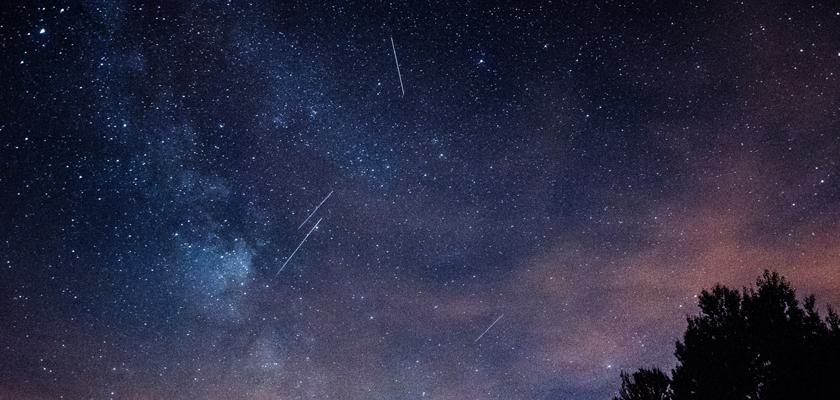The headlines created great expectations for the millions of mosquito-harassed people who stood outside in the dark of night looking for an anticipated Memorial Day weekend cosmic fireworks display. While it was not a total flop, the overhyped tau Herculids meteor shower was not the “once-in-a-lifetime event” Hearst Television-owned ABC television affiliate WPBF in West Palm Beach said that it would be. However, WPBF was only guilty of seizing upon the hype; it wasn’t responsible for creating the hype. Dramatic headlines were seen and heard across every form of electronic and print media as the holiday weekend began. Headlines touted the event: “Monday night meteor shower to be once-in-a-lifetime event”, "Crumbling Comet Could Create New Meteor Shower and an Epic Outburst Tonight”, and even, “See Tonight’s Potentially Historic New Meteor Shower’s 100,000 ‘Shooting Stars’” on the Forbes web site.
Bad headlines, bad science and even social media are nothing new. Long before news and rumors spread across the globe at the speed of light through fiber optic cable and electrons through wires, newspapers, gossip and word of mouth were often used as the “devil’s radio” as the late songwriter and performer George Harrison called it after he saw a church billboard that said, “Gossip: The Devil’s Radio…Don’t Be a Broadcaster.”
In the wake of the confusing and often contradictory media reporting and advice from public health officials throughout the COVID-19 pandemic, the disappointing and mediocre meteor display certainly didn’t help improve public trust of science. One man in Huntsville didn’t fall for the media hype and was pleased to see that the weak display Monday night was very close to what the predictive modeling that he relies on for meteor shower forecasts proved to be very reliable.
Bill Cooke is a professional astronomer and the manager of NASA’s Meteoroid Environment Program which provides meteor activity forecasts.
Cooke said, “We forecast meteor shower activity so that [the International Space Station astronauts and satellite operators] know when to batten down the hatches and stay inside the Space Station and it’s important that we get that right. We did the best we could with what we had, which wasn’t much as far as data was concerned, and we came up with a forecast and we predicted somewhere around fifteen meteors per hour, at most," as opposed to the thousand meteors per hour prediction being hyped at many media outlets. That forecast predicted a storm, “that was not even as good as the Perseids or the Geminids, probably on the same scale as the Lyriads meteor shower in April.”
Cooke said the data on the tau Herculids meteor shower was sparse because it was only reported once before, by a lone Japanese astronomer back in 1930.
“It’s not an annual meteor shower," the astronomer said.
The scarcity of useful data likely contributed to the wild speculation about thousands of meteors entering the Earth’s atmosphere as debris from a comet named Comet 73P/Schwassmann-Wachmann 3 that began to break to pieces back in 1995.
Cooke said that the comet orbits the sun every 5.4 years and, “When a comet breaks into pieces, we don’t have a model for that situation...so the big question was would the breakup produce enough material moving at a fast enough speed to get to Earth and that uncertainty was seized upon by some to say that there was going to be this meteor storm of your lifetime."
The maximum observed rate of meteors seen anywhere on Earth was about 25 meteors per hour Monday night when the shower peaked.
Cooke was proud to report, “From a NASA viewpoint, when you’re doing meteor shower forecasts to protect spacecraft, our prediction was a big success. We walked away happy, but if you were watching the shower from the deserts of Arizona, the shower wasn’t so much of a success because 25 meteors per hour is not the meteor shower of a lifetime…If you were looking for a sky full of fireworks, no, you did not see that.” Cooke also said that the meteors were too slow to produce the numerous big fireballs that many were hoping to see, but as is usual on any night of the year some people reported seeing a very few fireball type meteors around the nation Monday night.
An overhyped meteor show forecast wasn’t as bad as the public panic that occurred in 1910 when newspapers across the country such as the San Francisco Call headlined a story with “Comet May Kill All Earth Life Says Scientist.” The Earth was going to pass through the tail of the famous Halley’s Comet later that year, and the New York Times had reported on a claim by French scientist Camille Flammarion that “cyanogen gas (in the comet’s tail) would impregnate the atmosphere and possibly snuff out all life on the planet.” The Times report that “Cyanogen is a very deadly poison,” and “a grain of its potassium salt touched to the tongue [is] sufficient to cause instant death,” played into an atmosphere of public panic that inspired an Oklahoma religious group to propose warding off the end of the world by offering a human sacrifice and crooked schemes such as selling people a fake cyanide antidote.
Meteors do move at tens of thousands of miles an hour and pose a potential risk to life for astronauts in space as well as potentially destroying the very expensive satellites that we all rely on for everything from weather forecasting to navigation, national security, and for watching our favorite television programs, so it’s good to have someone like Bill Cooke and his NASA team in Huntsville scanning the depths of space for those hazardous leftovers of Creation.
To connect with the author of this story, or to comment, email jim.mcdade@1819news.com
Don’t miss out! Subscribe to our newsletter and get our top stories every weekday morning.









